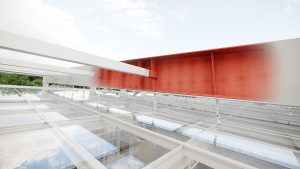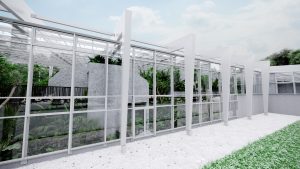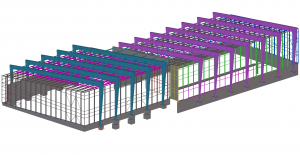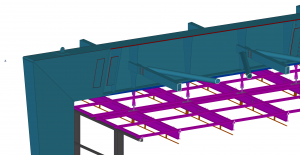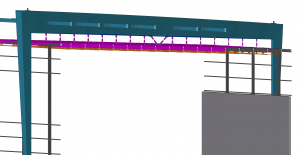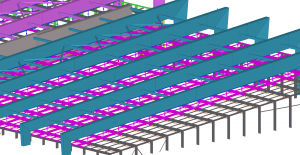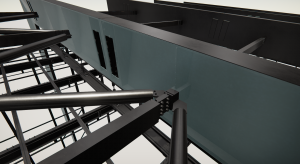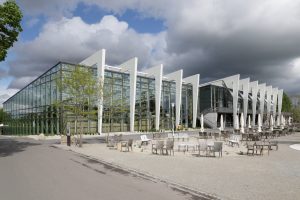Egapark Danakil
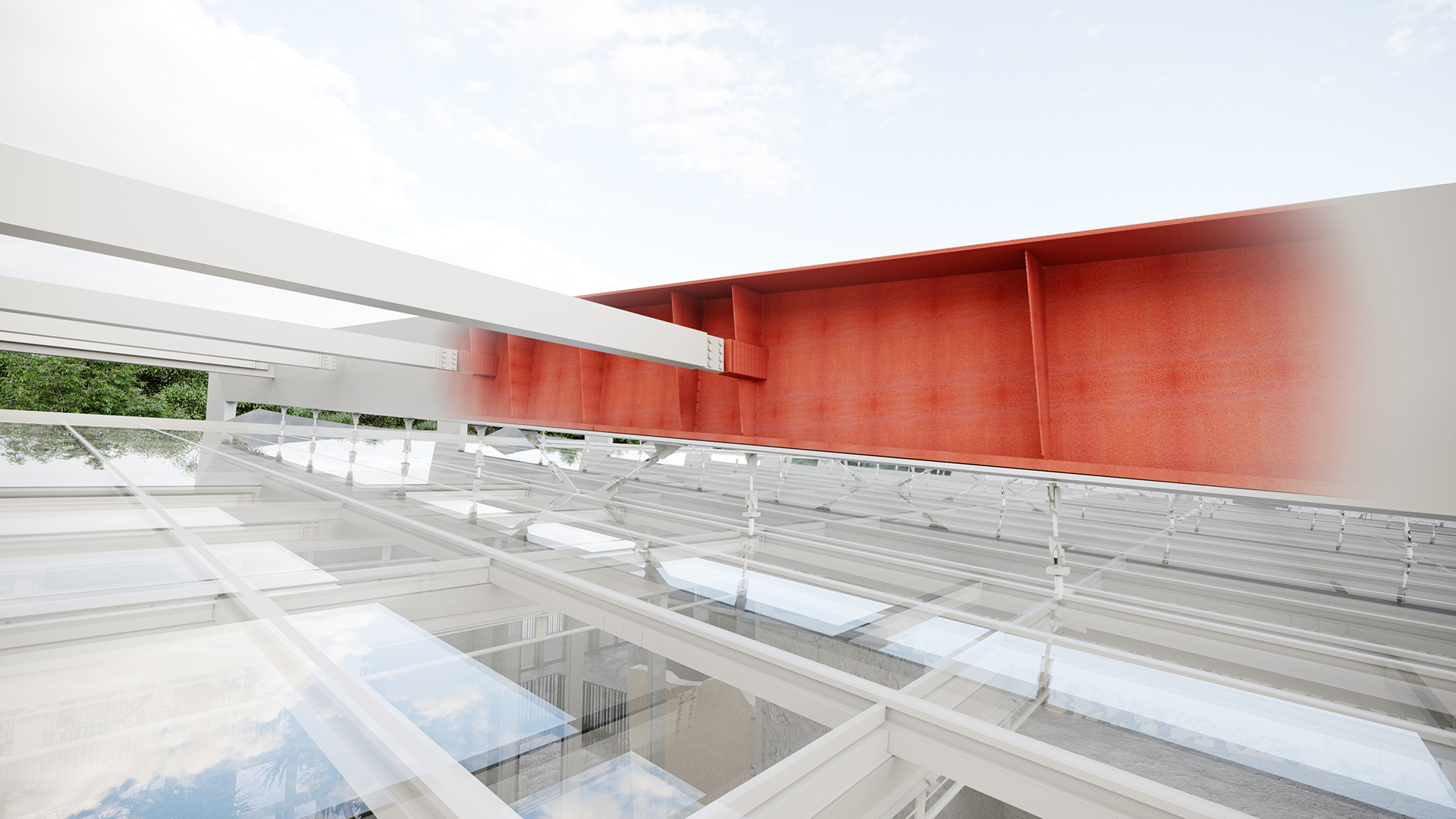
| Category | Commercial Projects |
|---|---|
| Year | 2022 |
| Country | Poland |
| Organization | PMJ Structural Engineering Sp. z o.o. Sp.k. |
| Author | PMJ Structural Engineering Sp. z o.o. Sp.k. |
| Client | Erfurter Garten- und Ausstellungs gemeinnützige GmbH |
| Place of construction | Niemcy, Erfurt |
| Tags |
Wystawa ogrodnicza BUGA w roku 2021 miała miejsce w Erfurcie. W centrum parku wystawowego powstał pokazowy projekt tej imprezy – Danakil, składający się z 2 pawilonów: Pustyni i Puszczy.
Charakter obiektowi nadaje jego konstrukcja główna (pierwotna). We wnętrzu natomiast widoczna jest delikatna, zredukowana do minimum konstrukcja drugorzędna.
Konstrukcję główną hali stanowią ramy dwuprzegubowe, ze smukłych stalowych elementów skrzynkowych o trapezowym przekroju. Rozpiętości ram wynoszą odpowiednio 33,0 m dla pawilonu Puszczy i 37,0 m dla pawilonu Pustyni. Odstępy między ramami wynoszą 6,36 m. Statycznie niezbędne wysokości przekrojów wynoszą maksymalnie 1,60 m. Ta wysokość osiągana jest w najwyższym punkcie rygla ramy.
Konstrukcja pierwotna znajduje się poza zewnętrzną przegrodą termiczną budynku, jaką stanowi przeszklenie ścian i dachu zamocowane do konstrukcji drugorzędnej.
Konstrukcja drugorzędna oraz podwieszony pod nią przeszklony dach hali, stanowią dach jednospadowy o nachyleniu 6°. Konstrukcja drugorzędna jest termicznie odizolowana od konstrukcji głównej, a odstęp w świetle pomiędzy górną powierzchnią przeszklenia i dolną krawędzią ramy wynosi ok. 50 cm. Wieszaki łączące obie konstrukcje przenikają przeszklenie fasady. Miejsca przenikania są uszczelnione i cieplnie zaizolowane.
Pod ramami konstrukcji głónej przebiegają profile nośne w kształcie szerokich teowników, niezbędne dla zapewnienia globalnej stabilności obiektu. Na nich opierają się podwójne ramki przeszklenia. Pomiędzy powierzchniami przeszklenia znajdują się wieszaki biegnące od konstrukcji głównej, wykonane jako okrągłe pręty ze stali nierdzewnej. Są one zamocowane przegubowo na obu końcach, aby zapewnić możliwość ruchu wzajemnie przemieszczającym się elementom konstrukcji głównej i wtórnej. Ruchy te wynikają z odkształceń termicznych: konstrukcja pierwotna poddana jest zmianom temperatury wraz z otoczeniem, konstrukcja wtórna natomiast ma temperaturę stałą, odpowiadającą temperaturze ogrzewanego wnętrza hali. Punktem stałym (nieruchomym) jest punkt leżący na żelbetowej ścianie oddzielającej oba pawilony.
Największymi wyzwaniami było prawidłowe zaprojektowanie podniesienia wykonawczego ram głównych oraz zapewnienie swobodnej pracy podwieszenia dolnej części konstrukcji, na którą wpływ miał mikroklimat panujący wewnątrz hal. Dodatkowo ze względów architektonicznych niezbędne było konstruowanie skomplikowanych ukrytych węzłów.
The BUGA gardening exhibition in 2021 took place in Erfurt. In the center of the exhibition park, a show project of this event was created – Danakil, consisting of 2 pavilions: Desert and Forest.
The character of the object is given by its main (primary) structure. Inside, however, there is a delicate secondary structure, reduced to a minimum.
The main structure of the hall consists of double-hinged frames, made of slender steel box elements with a trapezoidal cross-section. The spans of the frames are respectively 33.0 m for the Forest pavilion and 37.0 m for the Desert pavilion. The spacing between the frames is 6.36 m. The statically necessary section heights are up to 1.60 m. This height is reached at the highest point of the frame rafter.
The primary structure is located outside the building’s external thermal barrier, which is the glazing of the walls and the roof attached to the secondary structure.
The secondary structure and the glass roof of the hall based on it constitute a single-pitched roof with a slope of 6 °. The secondary structure is thermally insulated from the main structure, and the clear distance between the top of the glazing and the bottom edge of the frame is approx. 50 cm. Hangers connecting both structures penetrate the facade glazing. The places of penetration are sealed and thermally insulated.
Under the frames of the primary structure, there are supporting profiles in the shape of wide tees, necessary to ensure the global stability of the building. The double glazing frames are based on them. There are hangers from the main structure, made of round stainless steel bars, between the glazing surfaces. They are hinged at both ends to allow the movement of mutually moving parts of the main and secondary structures. These movements result from thermal deformations: the primary structure is subject to temperature changes along with the surroundings, while the secondary structure has a constant temperature, corresponding to the temperature of the heated hall interior. A fixed (stationary) point is a point lying on a reinforced concrete wall separating the two pavilions.
The biggest challenges in the project were the correct design of the cambering of the main frames and ensuring the correct suspension of the lower part of the structure, which was influenced by the thermal expansion of the “microclimates” inside the halls. Additionally, for architectural reasons it was necessary to construct hidden joints.
